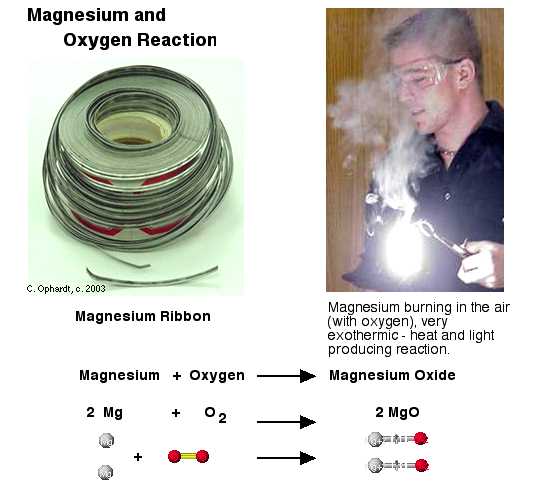Burning Magnesium
- Page ID
- 3106
\( \newcommand{\vecs}[1]{\overset { \scriptstyle \rightharpoonup} {\mathbf{#1}} } \)
\( \newcommand{\vecd}[1]{\overset{-\!-\!\rightharpoonup}{\vphantom{a}\smash {#1}}} \)
\( \newcommand{\dsum}{\displaystyle\sum\limits} \)
\( \newcommand{\dint}{\displaystyle\int\limits} \)
\( \newcommand{\dlim}{\displaystyle\lim\limits} \)
\( \newcommand{\id}{\mathrm{id}}\) \( \newcommand{\Span}{\mathrm{span}}\)
( \newcommand{\kernel}{\mathrm{null}\,}\) \( \newcommand{\range}{\mathrm{range}\,}\)
\( \newcommand{\RealPart}{\mathrm{Re}}\) \( \newcommand{\ImaginaryPart}{\mathrm{Im}}\)
\( \newcommand{\Argument}{\mathrm{Arg}}\) \( \newcommand{\norm}[1]{\| #1 \|}\)
\( \newcommand{\inner}[2]{\langle #1, #2 \rangle}\)
\( \newcommand{\Span}{\mathrm{span}}\)
\( \newcommand{\id}{\mathrm{id}}\)
\( \newcommand{\Span}{\mathrm{span}}\)
\( \newcommand{\kernel}{\mathrm{null}\,}\)
\( \newcommand{\range}{\mathrm{range}\,}\)
\( \newcommand{\RealPart}{\mathrm{Re}}\)
\( \newcommand{\ImaginaryPart}{\mathrm{Im}}\)
\( \newcommand{\Argument}{\mathrm{Arg}}\)
\( \newcommand{\norm}[1]{\| #1 \|}\)
\( \newcommand{\inner}[2]{\langle #1, #2 \rangle}\)
\( \newcommand{\Span}{\mathrm{span}}\) \( \newcommand{\AA}{\unicode[.8,0]{x212B}}\)
\( \newcommand{\vectorA}[1]{\vec{#1}} % arrow\)
\( \newcommand{\vectorAt}[1]{\vec{\text{#1}}} % arrow\)
\( \newcommand{\vectorB}[1]{\overset { \scriptstyle \rightharpoonup} {\mathbf{#1}} } \)
\( \newcommand{\vectorC}[1]{\textbf{#1}} \)
\( \newcommand{\vectorD}[1]{\overrightarrow{#1}} \)
\( \newcommand{\vectorDt}[1]{\overrightarrow{\text{#1}}} \)
\( \newcommand{\vectE}[1]{\overset{-\!-\!\rightharpoonup}{\vphantom{a}\smash{\mathbf {#1}}}} \)
\( \newcommand{\vecs}[1]{\overset { \scriptstyle \rightharpoonup} {\mathbf{#1}} } \)
\( \newcommand{\vecd}[1]{\overset{-\!-\!\rightharpoonup}{\vphantom{a}\smash {#1}}} \)
\(\newcommand{\avec}{\mathbf a}\) \(\newcommand{\bvec}{\mathbf b}\) \(\newcommand{\cvec}{\mathbf c}\) \(\newcommand{\dvec}{\mathbf d}\) \(\newcommand{\dtil}{\widetilde{\mathbf d}}\) \(\newcommand{\evec}{\mathbf e}\) \(\newcommand{\fvec}{\mathbf f}\) \(\newcommand{\nvec}{\mathbf n}\) \(\newcommand{\pvec}{\mathbf p}\) \(\newcommand{\qvec}{\mathbf q}\) \(\newcommand{\svec}{\mathbf s}\) \(\newcommand{\tvec}{\mathbf t}\) \(\newcommand{\uvec}{\mathbf u}\) \(\newcommand{\vvec}{\mathbf v}\) \(\newcommand{\wvec}{\mathbf w}\) \(\newcommand{\xvec}{\mathbf x}\) \(\newcommand{\yvec}{\mathbf y}\) \(\newcommand{\zvec}{\mathbf z}\) \(\newcommand{\rvec}{\mathbf r}\) \(\newcommand{\mvec}{\mathbf m}\) \(\newcommand{\zerovec}{\mathbf 0}\) \(\newcommand{\onevec}{\mathbf 1}\) \(\newcommand{\real}{\mathbb R}\) \(\newcommand{\twovec}[2]{\left[\begin{array}{r}#1 \\ #2 \end{array}\right]}\) \(\newcommand{\ctwovec}[2]{\left[\begin{array}{c}#1 \\ #2 \end{array}\right]}\) \(\newcommand{\threevec}[3]{\left[\begin{array}{r}#1 \\ #2 \\ #3 \end{array}\right]}\) \(\newcommand{\cthreevec}[3]{\left[\begin{array}{c}#1 \\ #2 \\ #3 \end{array}\right]}\) \(\newcommand{\fourvec}[4]{\left[\begin{array}{r}#1 \\ #2 \\ #3 \\ #4 \end{array}\right]}\) \(\newcommand{\cfourvec}[4]{\left[\begin{array}{c}#1 \\ #2 \\ #3 \\ #4 \end{array}\right]}\) \(\newcommand{\fivevec}[5]{\left[\begin{array}{r}#1 \\ #2 \\ #3 \\ #4 \\ #5 \\ \end{array}\right]}\) \(\newcommand{\cfivevec}[5]{\left[\begin{array}{c}#1 \\ #2 \\ #3 \\ #4 \\ #5 \\ \end{array}\right]}\) \(\newcommand{\mattwo}[4]{\left[\begin{array}{rr}#1 \amp #2 \\ #3 \amp #4 \\ \end{array}\right]}\) \(\newcommand{\laspan}[1]{\text{Span}\{#1\}}\) \(\newcommand{\bcal}{\cal B}\) \(\newcommand{\ccal}{\cal C}\) \(\newcommand{\scal}{\cal S}\) \(\newcommand{\wcal}{\cal W}\) \(\newcommand{\ecal}{\cal E}\) \(\newcommand{\coords}[2]{\left\{#1\right\}_{#2}}\) \(\newcommand{\gray}[1]{\color{gray}{#1}}\) \(\newcommand{\lgray}[1]{\color{lightgray}{#1}}\) \(\newcommand{\rank}{\operatorname{rank}}\) \(\newcommand{\row}{\text{Row}}\) \(\newcommand{\col}{\text{Col}}\) \(\renewcommand{\row}{\text{Row}}\) \(\newcommand{\nul}{\text{Nul}}\) \(\newcommand{\var}{\text{Var}}\) \(\newcommand{\corr}{\text{corr}}\) \(\newcommand{\len}[1]{\left|#1\right|}\) \(\newcommand{\bbar}{\overline{\bvec}}\) \(\newcommand{\bhat}{\widehat{\bvec}}\) \(\newcommand{\bperp}{\bvec^\perp}\) \(\newcommand{\xhat}{\widehat{\xvec}}\) \(\newcommand{\vhat}{\widehat{\vvec}}\) \(\newcommand{\uhat}{\widehat{\uvec}}\) \(\newcommand{\what}{\widehat{\wvec}}\) \(\newcommand{\Sighat}{\widehat{\Sigma}}\) \(\newcommand{\lt}{<}\) \(\newcommand{\gt}{>}\) \(\newcommand{\amp}{&}\) \(\definecolor{fillinmathshade}{gray}{0.9}\)The property displayed in this demonstration uses magnesium metal to display what happens to metal when it reacts with oxygen gas, that is found in the air around us. Magnesium metal and its alloys are explosive hazards; they are highly flammable in their pure form when molten or in powder or in ribbon form. Burning or molten magnesium metal reacts violently with water. When working with powdered magnesium, safety glasses with welding eye protection are employed, because the bright white light produced by burning magnesium contains ultraviolet light that can permanently damage eyes.
Burning Magnesium
Reaction
When magnesium is in its metal form it will burn very easily in air. However, in order to start the reaction (the burning) the magnesium metal needs a source of energy. The flame provides a source of heat so that the magnesium metal atoms can overcome their activation energy. Activation energy is the minimum energy required in order for a chemical reaction to proceed. When the magnesium metal burns it reacts with oxygen found in the air to form Magnesium Oxide. A compound is a material in which atoms of different elements are bonded to one another. Oxygen and magnesium combine in a chemical reaction to form this compound. After it burns, it forms a white powder of the magnesium oxide. Magnesium gives up two electrons to oxygen atoms to form this powdery product. This is an exothermic reaction. An exothermic reaction is a term that describes a chemical reaction in which there is a net release of energy (heat).
\[2 Mg_{(s)} + O_{2 \;(g)} \rightarrow 2 MgO_{ (s)} + \text{energy} \tag{1}\]
Magnesium is also capable of reducing water to the highly-flammable hydrogen gas, which will be ignited by the excess heat given by the reduction reaction.
\[Mg_{(s)} + 2H_2O \rightarrow Mg(OH)_{2\; (s)} + H_{2 \;(g)} \tag{2}\]
Magnesium also reacts with carbon dioxide to form magnesium oxide and carbon:
\[Mg_{(s)} + CO_2 \rightarrow 2 MgO_{(s)} + C_{(s)} \tag{3}\]
Hence, carbon dioxide fire extinguishers cannot be used for extinguishing magnesium fires either. Burning magnesium is usually quenched by using a Class D dry chemical fire extinguisher, or by covering the fire with sand to remove its air source.
Materials
- strip of magnesium metal ribbon - 4 inches long
- lighter
Directions
- Hold the piece of magnesium metal ribbon in a pair of tongs.
- Take the lighter and hold the magnesium metal ribbon in the hottest part of the flame.
- It will soon catch fire and emit a very bright light.
- CAUTION DO NOT LOOK DIRECTLY AT THE BRIGHT LIGHT. Briefly gaze at the light out of the corner of your eye.

Safety
- Wear goggles.
- Do not let children do this.
- Do not look directly at the light emitted from the metal.
- Make sure you hold the metal securely with the tongs.
- Keep away from combustible materials.
Remember that water cannot extinguish magnesium fires and will produce hydrogen gas (\(H_2\)) that will only intensify the fire. Wear goggles that filter out UV light. Throw the powder in the garbage.
References
- Shakhashiri, Bassam Z. "Chemical Demonstrations", U. Wisconsin Press, 1983,Vol. 1, p.38.
- http://www.angelo.edu/faculty/kboudr..._magnesium.htm
- http://www.newton.dep.anl.gov/askasc.../chem03362.htm
- Driscoll, Jerry A. "Demonstration of burning magnesium and dry ice (TD)." J. Chem. Educ. 1978, 55, 450.
- Feinstein, H. I. "Ignition of magnesium in porcelain." J. Chem. Educ. 1982, 59, 159.
- Laing, Michael. "A WARNING: Explosion Hazards of Reacting Magnesium and Aluminum with Powdered Silver Nitrate (LTE)." J. Chem. Educ. 1994, 71, 270.
- Moyer, Ralph O. "Synthesis and structure of magnesium oxide or calcium oxide. An integrated inorganic-physical experiment." J. Chem. Educ. 1975, 52, 612.
Contributors
- Charles Ophardt, Professor Emeritus, Elmhurst College; Virtual Chembook

